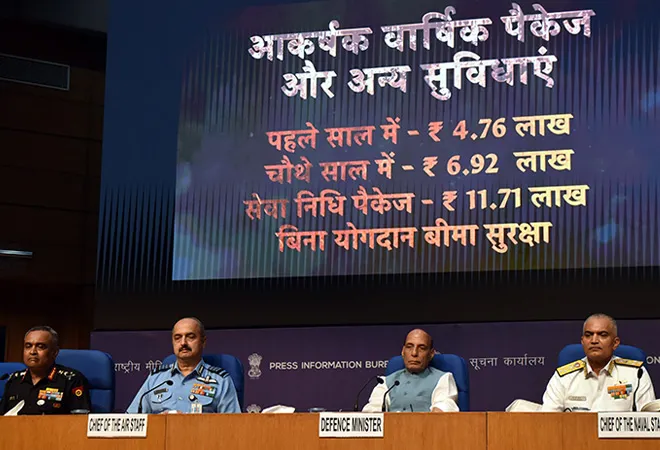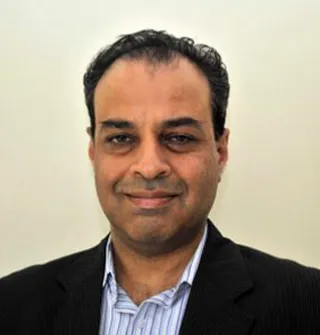 This piece is part of the essay series, The Agneepath Scheme: Radical or Irrational?
This piece is part of the essay series, The Agneepath Scheme: Radical or Irrational?
The Tour of Duty (ToD) scheme for enlistment in the military has been drawing
protests from across the country. Many young aspirants are agitated over what they see as a system of contractual employment, with no assurance of a permanent job and pension. In a bid to assuage the protestors, the government has announced a 10-percent reservation for the ‘Agniveers’ in public sector units and the paramilitary, but this is yet to allay apprehensions of the rioters.
The scheme has also divided the veterans’ community. Some have
endorsed ‘Agnipath’, calling it a “fine idea whose time has come”. With modernisation and reform being a priority for the armed forces, proponents say the scheme is a step in the right direction. Others remain unconvinced. A section of veterans has
criticised the scheme, calling it impractical and unimplementable.
In a bid to assuage the protestors, the government has announced a 10-percent reservation for the ‘Agniveers’ in public sector units and the paramilitary, but this is yet to allay apprehensions of the rioters.
A radical idea?
The
supporters of the TOD see it as a transformative idea. The scheme—under which 45,000 people between the age of 17–21 years are to be inducted into the services for a four-year tenure—they say, is an
essential reform to modernise the military. Not only would it create a tech-savvy force—future-ready men and women with the training and capability to lead troops in a high-tech battle environment, but it would also reduce the age profile of the army. The intent, they aver, is to create a skilled, disciplined, and motivated force that will propel the nation onto a growth trajectory.
Those that back the scheme place great store by the emoluments and
opportunities that are being offered. With a fixed salary of around INR30,000 per month with annual increments, hardship and travel allowance, Agniveers will have a healthy monetary package. For the duration of their stay in the military, the recruits will get medical facilities, leave, canteen facilities, and a life insurance cover of INR48 lakh. A skill-set certificate at the end of their engagement period is likely to bolster their prospects in the job market.
Meanwhile, a non-lapsable ‘
Agniveer Corpus Fund’ will receive a contribution of 30 percent from the salary of each individual, accumulating an interest equivalent to the Public Provident Fund. A tax-exempt “Seva Nidhi” package of nearly INR12 lakhs is intended to help Agniveers resettle themselves after leaving the military. The government has also decided to give a three-year age
relaxation beyond the prescribed upper age limit to Agniveers for recruitment in Central Armed Police Forces (CAPFs) and Assam Rifles. For the first batch of Agniveer, the age relaxation will be for five years beyond the prescribed upper age limit.
With a fixed salary of around INR30,000 per month with annual increments, hardship and travel allowance, Agniveers will have a healthy monetary package.
Prevailing apprehensions
But the questions surrounding ToD are still troubling. The programme,
sceptics say, is entirely untested. For a scheme that will be the principal mode of recruitment across the three services, there has been no independent study, pilot project and or test run to ascertain the viability of the scheme for the military. Starting small would have helped identify the loopholes in the model, and also aided authorities in addressing apprehensions amongst aspirants in rural areas, from where the bulk of recruits in the services are drawn (particularly in the Indian Army). But ToD is seemingly being driven from the top—implemented without consideration of modalities. Equally worrying is the
lack of clarity about how so many Agniveers will be inducted, trained, and then discharged in a short period of four years. Many ask how will a mere six months of training suffice to master warfighting skills. With little specialisation, how will Agniveers be deployed on the frontlines of a warzone? Considering the short duration of their employment, how will the performance be evaluated? Will demobilised Agniveers be accommodated in other government jobs? Many raise doubts about the scheme’s viability and sustainability over the long run.
As some see it, the scheme is a
cost-cutting exercise to reduce the government's salary and pension bill and free up funds for military modernisation. Modernisation, they say, should not be the soldier’s cross to carry. As a naval veteran
put it: “Jawans and PBORs endure service hardships for two simple reasons: Loyalty—to be commanded by good leadership—and the contract of pension and medical cover. The former makes them seek re-engagement” during a downturn. The latter keeps them from starving or living a life of indignity. Both are excluded in the TOD.” The promise of “lateral absorption” in the CAPFs will be hard to deliver. The CAPF’s resistance to the entry of demobilised soldiers in the paramilitary is well known.
Many worry that the ‘Agnipath’ programme could potentially
militarise the society. With their ambitions of serving in the military for a full 15 years, frustrated and unemployed, the demobilised Agniveers could fall prey to the lure of crime syndicates and radical political outfits. Some could join the ranks of overseas mercenary groups and private militias. Such fears might appear to be exaggerated but they aren’t entirely unfounded.
The scheme is a cost-cutting exercise to reduce the government's salary and pension bill and free up funds for military modernisation.
The ToD also threatens to disturb the
social composition of the army. The scheme is aimed at ending the Indian Army’s time-tested regimental structure and replacing it with All-India, All-Class (AIAC) mixed units. This could adversely affect the army’s overall soldiership, eroding camaraderie, kinship and cohesion within military units. With the scheme abolishing state quotas for employment, the army’s ranks could well become northern states heavy, disturbing the regional balance within the military.
There are related issues regarding the military’s capacity to carry out
recruitment of Agniveers. It is clear that recruitment staff in the Army will need to be multiplied manifold, straining the existing capacity of the force. It would also mean increasing the tail-to-teeth ration, with more battle-hardened men training young recruits, and a year-on-year rising strength of contract soldiers. The most important question concerns retention of Agniveers in service. The proposed training period of 26 weeks for basic military training is unlikely to be enough for recruits to gain sufficient knowledge and exposure to meaningfully contribute to their units. How, then, would the commanding officers decide which 25 percent Agniveers to retain and which 75 percent to send home.
From an operational perspective, too, there are
downsides that haven’t been accounted for. A military which requires to train soldiers for combat and fight with regimental affiliation on the toughest battlefields in the world, cannot be conscript heavy. Agniveers in the Indian Army are likely to be risk averse and unlikely to develop solidarity with their experienced comrades that thrive on the motto of ‘Naam-Namak-Nishan’. The former would need hand-holding and protection in hazardous operational conditions. If they made it safely to the end of their tenure, many Agniveers will need to go back and study to resettle themselves. Those that do not, would find their career choices curtained by their limited skill sets.
The proposed training period of 26 weeks for basic military training is unlikely to be enough for recruits to gain sufficient knowledge and exposure to meaningfully contribute to their units.
Its transformational potential notwithstanding, the ToD, then, seems less than fit for the purpose. The scheme needs a relook to reconcile personnel aspirations with military imperatives. In the main, it must provide firm guarantees of jobs and pension to young recruits. It must do more to assure the soldier on the frontline that he will not be cast adrift when his service comes to an end or that in the event of his death in harness, his family would be taken care of.
The views expressed above belong to the author(s). ORF research and analyses now available on Telegram! Click here to access our curated content — blogs, longforms and interviews.



 This piece is part of the essay series,
This piece is part of the essay series,  PREV
PREV


